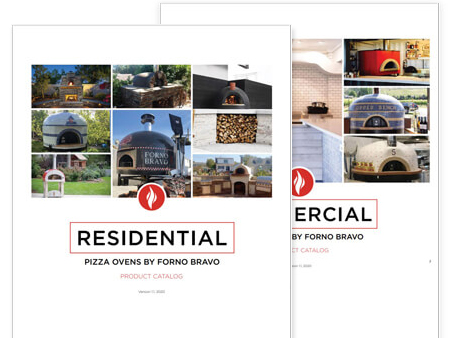Am I Drying-Out or Curing My Oven?
Apr 10, 2012Posted by Forno BravoOne interesting aspect of the modern brick oven is the degree to which it shares technology with industrial equipment—including furnaces. As designers, we use both raw materials and manufactured products to build ovens that are light weight, that are resistant to thermal cycling (heat up and cool down cycles), that are resistant to thermal shock (putting cold, wet pizza dough on a very hot ceramic surface), that hold high heat while being fired, that hold moderate heat for long periods of time after firing, and that are simultaneously hot on the inside and cool on the outside.
In general, the pizzas oven and heavy industry share technology in harmony.
But there is one area of disconnect. Language. For years the pizza oven industry has used the term “curing” to describe the process of slowly baking out the water that is used in the oven manufacturing process—including castables and mortars. When in fact this is technically the “drying out” process.
In refractory language, the term “curing” describes the process of bringing a refractory material up to a high temperature, just below their melting point, to where they sinter—powder particles are joined together through a chemical reaction, thereby decreasing the porosity of the compound and increasing its strength and density. A simple type of sintering occurs when to ice cubes fuse together in a glass of water. For aluminum oxide (Al2O3), sintering takes place at 1400-1650ºC, far hotter than your pizza oven will ever reach. In fact, for some high temperature refractories where the binder is not sufficiently heat resistant for the application, the curing process is so hot that the refractory binder (calcium aluminate in the case of a pizza oven) is actually burned out, and the resulting sintered aggregate creates the final, high temperature resistant compound.
As a side note, calcium aluminate (the binder used in pizza ovens) has a service temperature in excess of 2300ºF—again far hotter than your oven will ever reach. One thing that this information underscores is the importance of the hydraulic ceramic bond formed by the calcium aluminate binder and the refractory aggregates in our new, third-generation FB Castable. By using different sizes and shapes of calcined refractory aggregate, FB Castable creates an extremely strong ceramic bond—and delivers an industry-leading 8,320 psi compression strength.
All of which I think is pretty interesting.
Going forward, Forno Bravo will continue to use the term “curing” in our written materials to describe the “drying out” process and we will continue to stress the importance of proper oven curing (and drying out) for the performance and longevity of your oven.
Remember, that water turns to steam at 212ºF (100ºC), that water expands in volume 1600 times when it is converted to steam, and that water converted to steam inside your oven will create cracks which will compromise and ruin your oven. So please follow the oven curing/dry out schedule.
In fact, the drying out process is so interesting, we are going to be writing more about that a little later.






